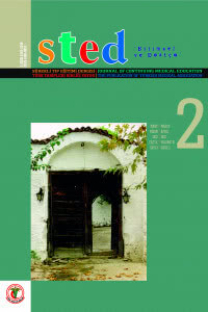Tıp Eğitimi Çoklu Ortam Uygulamalarında Yeni Bir Bakış Açısı: Artırılmış Gerçeklik
A New Perspective to Multimedia Applications in Medical Education: Augmented Reality
___
- Deveci-Topal A, Ocak MA. Harmanlanmış öğrenme ortamı ile hazırlanan anatomi dersinin öğrencilerin akademik başarıları üzerindeki etkisi. Eğitim Teknolojisi Kuram ve Uygulama 2014; 4:1
- Khalil MK, Lamar CH, Johnson TE. Using computer-based interactive imagery strategies for designing instructional anatomy programs. Clinical Anatomy 2005;18:68-76
- Alkhamisi AO, Monowar,MM. Rise of augmented reality: Current and future application areas. International Journal of Internet and Distributed Systems 2013;1:25- 34.
- Krevelen DWFV, Poelman R. A survey of augmented reality technologies, applications and limitations. The International Journal of Virtual Reality 2010;9(2):1-20.
- Azuma R. A survey of augmented reality. Presence: T Teleoperators and Virtual Environments 1997;6(4):355-385.
- Wu HK, Lee SWY, Chang HY, Liang JC.Current status, opportunities and challenges of augmented reality in education. Comp and Educ 2013;62;41-9.
- Kamphuis C, Barsom E, Schijven M, Christoph N. Augmented reality in medical education? Perspectives on Med Educ 2014;4(1):300-11.
- Cheng KH, Tsai CC. Affordances of augmented reality in science learning: Suggestions for future research. Journal of Science Education and Technology 2012;22;449-62.
- Hamza-Lup FG. A distributed augmented reality system for medical training and simulation. University of Central Florida Orlando 2009.
- Bajura M, Fuchs H, Ohbuchi R. Merging virtual objects with the real world: Seeing ultrasound imagery within the patient. Proceedings of the 19th Annual Conference on Computer Graphics and Interactive Techniques 1992;203-10.
- Fuchs HM, Livingston A, Raskar RD, Colucci K, Keller A, State JR, Crawford P, Rademacher D, SH, Meyer AA. Augmented reality visualization for laparoscopic surgery. Medical Image Computing and Computer-Assisted Intervention 1998;1496: 934-43.
- Merten M. Erweiterte realität-verschmelzung zweier welten. Deutsches Ärzteblatt 2007;104(13):840-2.
- Navab N, Traub J, Sielhorst T, Feuerstein M, Bichlmeier C. Action- and workflow-driven augmented reality for computer- aided medical procedures. IEEE Computer Graphics and Applications 2007;10-4.
- Nicolau S, Soler L, Mutter D, Marescaux J. Augmented reality in laparoscopic surgical oncology. Surg Onc 2011;20(3):189-201.
- Fischer J, Neff M, Freudenstein D, Bartz D. Medical augmented reality based on commercial image guided surgery. Eurographics Symposium on Virtual Environments 2004.
- LeBlanc F, Champagne BJ, Augestad KM, Neary P., Senagore AJ, Ellis CN, Delaney CP. A comparison of human cadaver and augmented reality simulator models for straight laparoscopic colorectal skills acquisition training. Journal of the American College of Surgeons 2010;211(2):250-255.
- Chien CH, Chen CH, Jeng TS. An interactive augmented reality system for learning anatomy structure. Proceedings of International Conference of Engineers and Computer Scientists 2010;370-75.
- Thomas RG, John NW, Delieu JM. Augmented reality for anatomical education. Journal of Visual Communication in Medicine 2010;33(1):6-15.
- Yeom S, Choi-Lundberg D, Fluck A, Sale A. User acceptance of a haptic interface for learning anatomy, Proceedings of the IADIS International Conference on eLearning 2013, IADIS Press International Association for Development of the Information Society 2013:239-46.
- Patirupanusara P. Marker-based augmented reality magic book for anatomical education. International Conference on Computer and Communication Technologies 2012.
- Blum TVK. Miracle: An augmented reality magic mirror system for anatomy education. Virtual Reality Conference 2012;115-16.
- Jan VU, Noll C. Behrends M., Albrechti V. mARble - Augmented reality in medical education. Biomed Tech, 57,67-70.
- Meng M, Fallavollita P, Blum T, Eck U, Sandor C, Weidert S, Waschke J. Navab N. Kinect for interactive AR anatomy learning, IEEE International Symposium on Mixed and Augmented Reality 2013.
- Ferrer-Torregrosa J, Torralba J, Jimenez MA, Garcı´a S, Barcia, JM. ARBOOK: Development and assessment of a tool based on augmented reality for anatomy. Journal of Sci Educ and Tech 2014.
- McLachlan J, Bligh C, Searle J. Teaching anatomy without cadavers. Med Educ 2004;38(4):418-24.
- Rasch T, Schnotz W. Interactive and non-interactive pictures in multimedia learning environments: effects on learning outcomes and learning efficiency. Learn and Instruc 2009;19:411-22.
- ISSN: 1300-0853
- Yayın Aralığı: 6
- Başlangıç: 1992
- Yayıncı: -
Gebelerin Prenatal Bağlanma Düzeyleri ve Bunları Etkileyen Faktörler
Çocuğun Uyku Ortamı Nasıl Olmalıdır?
Savaş ve Çatışma Ortamında Kadın Sağlığı
Metin KILIÇ, Müsenna ARSLANYILMAZ, ÜMMÜHAN ŞEVKAT BAHAR ÖZVARIŞ
Tıp Eğitiminde Kullanılan Etkileşimli Videolar ile İlgili Öğrenci Görüşlerinin İncelenmesi
ELİF TAŞLIBEYAZ, ONUR BURAK DURSUN, SELÇUK KARAMAN
Tekin Ulaş KARATEPE, Bahar GÜNER
Tıp Eğitimi Çoklu Ortam Uygulamalarında Yeni Bir Bakış Açısı: Artırılmış Gerçeklik
